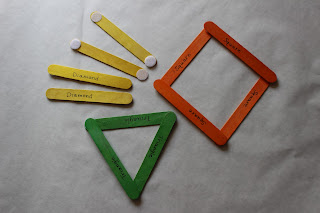L is now attending preschool 4 half days a week. I have decided to make some practice sheets for him to do at home when he wants to do schoolwork.
Materials:
1) card stock
2) contact paper
3) wet or dry erase marker
 |
| Numbers and Number Words |
 |
| Color Words |
 |
| Lowercase Letters (o-z on back) |
 |
| Uppercase Letters (O-Z on back) |
 |
| First and Last name | | |
|
Side note on the first and last name-I taught L how to write his name with all capital letters. Which is fine, they are usually the easiest to form. But the second he stepped into his new classroom his name was written with the capital "L" and the lowercase "andon". I'm thinking I should have done this to begin with. Also, his school has adopted the Handwriting Without Tears curriculum, which is okay because I taught him using Zaner Bloser handwriting, not D'Nealian. I would suggest finding out which handwriting curriculum your student's future school uses and try to teach that.
 |
| Create your pages, print on card stock, cover with contact paper (or laminate them) and use a wet or dry erase marker to practice forming the letters, words, and name. |
|
This activity reinforces letter and number formation, number word recognition, color word recognition, fine motor skills, and writing skills. This is such an easy and cheap activity to make! My next thought is to punch holes in them and store in a 3-ring binder. Then L will have a binder full of dry erase practice pages!
Other variations could be:
~ a page with shapes to trace (with the names)
~ a page with random dotted lines to trace
~ print any tracing page off your favorite website
Once your student is reading:
~ sight words
~ family names
~ days of the week
~ months of the year
~ print any practice page off the internet (laminating reduces the wasted paper-although we have wasted our fair share of paper)
The possibilities are endless! See my favorite websites for more ideas of pages to print and laminate!
By the way, all of my kiddos LOVE having their own activities and places
to keep their activities. When I make a new activity and we find a
place for it I make sure to reinforce ownership of it (meaning they are
to take care of it, use it correctly, and put it away correctly).













































 Letter Tiles
Letter Tiles


